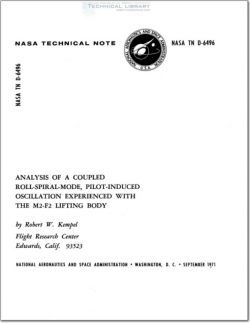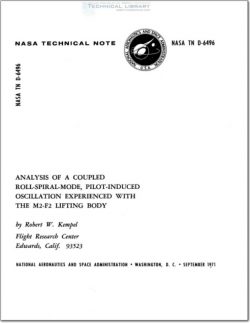NASA-TN-D-6496

- Version
- 194 Downloads
- 2.85 MB File Size
- 1 File Count
- June 16, 2016 Create Date
- June 16, 2016 Last Updated
Analysis of a Coupled Roll-Spiral-Mode, Pilot Induced Oscillation Experienced with the M2-F2 Lifting Body

During the 16 glide flights of the M2—F2 flight—test program, the pilot—vehicle
combination experienced severe lateral divergent oscillations on three occasions. The
oscillation on the last flight contributed to a gear—up landing in which the vehicle was
extensively damaged. Each of the three oscillations occurred when the pilots were at—
tempting to control bank angle closely at angles of attack below zero, and each oscilla—
tion was aggravated by attempts to coordinate aileron control with the rudders.
Reference 1 summarizes, qualitatively, the overall lateral-directional and longi—
tudinal stability and control characteristics of the M2 ~F2 vehicle for the 16 glide flights.
However, dynamic -stability problems involving a pilot—airframe combination cannot
be analyzed by considering only a few major static parameters. A systems analysis of
the transfer functions involved is required to determine the cause of dynamic —stability
problems. The problem of pilot—vehicle combination instability is generally referred
to as a pilot—induced oscillation, or PIO. References 2 and 3 treat this subject in de-
tail.
This report identifies the M2 —F2 stability and control problem by means of a sys—
tems analysis, which provides a quantitative understanding of the problem and its im-
plications. The transfer function of primary interest was the bank-angle —to —aileron
deflection. The transfer—function denominator quartic was factored into two second—
order factors rather than the more conventional two first—order factors (roll and spiral
modes) and a quadratic (Dutch roll mode). The combination of the two first—order
factors into a second quadratic has been termed roll—spiral coupling (refs. 4 to 8).
Very little flight data are available on vehicles which display roll-spiral coupling; how—
ever, reference 4 presents the results of an in—flight investigation of this phenomenon
utilizing a variable —stability T—33 aircraft. Other investigators (refs. 5 to 8) limited
their analysis to mathematical approaches or simulator studies, or both. In general,
these investigators concluded that a vehicle with roll-spiral —coup1ing characteristics
also has degraded lateral handling characteristics.
| File | Action |
|---|---|
| NASA-TN-D-6496 Analysis of a Coupled Roll-Spiral-Mode, Pilot Induced Oscillation Experienced with the M2-F2 Lifting Body.pdf | Download |

Comment On This Post